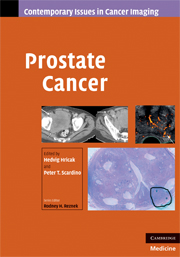Book contents
- Frontmatter
- Contents
- Contributors
- Series Foreword
- Preface
- 1 Anatomy of the prostate gland and surgical pathology of prostate cancer
- 2 The natural and treated history of prostate cancer
- 3 Current clinical issues in prostate cancer that can be addressed by imaging
- 4 Surgical treatment of prostate cancer
- 5 Radiation therapy
- 6 Systemic therapy
- 7 Transrectal ultrasound imaging of the prostate
- 8 Computed tomography imaging in patients with prostate cancer
- 9 Magnetic resonance imaging of prostate cancer
- 10 Magnetic resonance spectroscopic imaging and other emerging magnetic resonance techniques in prostate cancer
- 11 Nuclear medicine: diagnostic evaluation of metastatic disease
- 12 Imaging recurrent prostate cancer
- Index
- Plate section
- References
5 - Radiation therapy
Published online by Cambridge University Press: 23 December 2009
- Frontmatter
- Contents
- Contributors
- Series Foreword
- Preface
- 1 Anatomy of the prostate gland and surgical pathology of prostate cancer
- 2 The natural and treated history of prostate cancer
- 3 Current clinical issues in prostate cancer that can be addressed by imaging
- 4 Surgical treatment of prostate cancer
- 5 Radiation therapy
- 6 Systemic therapy
- 7 Transrectal ultrasound imaging of the prostate
- 8 Computed tomography imaging in patients with prostate cancer
- 9 Magnetic resonance imaging of prostate cancer
- 10 Magnetic resonance spectroscopic imaging and other emerging magnetic resonance techniques in prostate cancer
- 11 Nuclear medicine: diagnostic evaluation of metastatic disease
- 12 Imaging recurrent prostate cancer
- Index
- Plate section
- References
Summary
Introduction
Radiation therapy has played a significant role in the management of prostate cancer for over half a century. High-energy megavoltage linear accelerators developed in the 1950s provided deeper penetration of tumoricidal dose, superficial tissue sparing and hence lower morbidity profiles than earlier models. The introduction of the CT scanner and complex computer-based treatment planning software in the 1980s improved three-dimensional target localization and enhanced accuracy. Subsequently, intensity-modulated treatment planning capabilities enabled highly conformal dose escalation for improved outcomes without added toxicity. New image-guidance techniques have further refined treatment delivery by compensating for internal organ variability. Concurrent with vast improvements in external beam radiation therapy, modern brachytherapy methods, facilitated by dynamic imaging, have become sophisticated and popular techniques for primary as well as salvage therapies. In addition, refinement of prognostic factors, particularly prostate-specific antigen (PSA), and contemporary imaging for staging have substantially improved patient selection for individualized therapy.
Today, modern radiotherapeutic approaches rely on accurate staging, precise imaging, and prognostic prediction, as well as technical advances in dose delivery and normal tissue protection.
Imaging for patient selection and radiation treatment planning
An accurate staging assessment prior to definitive therapy is critical in order to maximize cure rates. Prognostic risk factors including American Joint Commission on Cancer (AJCC) stage, Gleason score and pre-treatment PSA assess the risk of disease beyond the prostate, predict the yield of diagnostic studies, and guide radiotherapeutic decision-making.
- Type
- Chapter
- Information
- Prostate Cancer , pp. 58 - 92Publisher: Cambridge University PressPrint publication year: 2008



